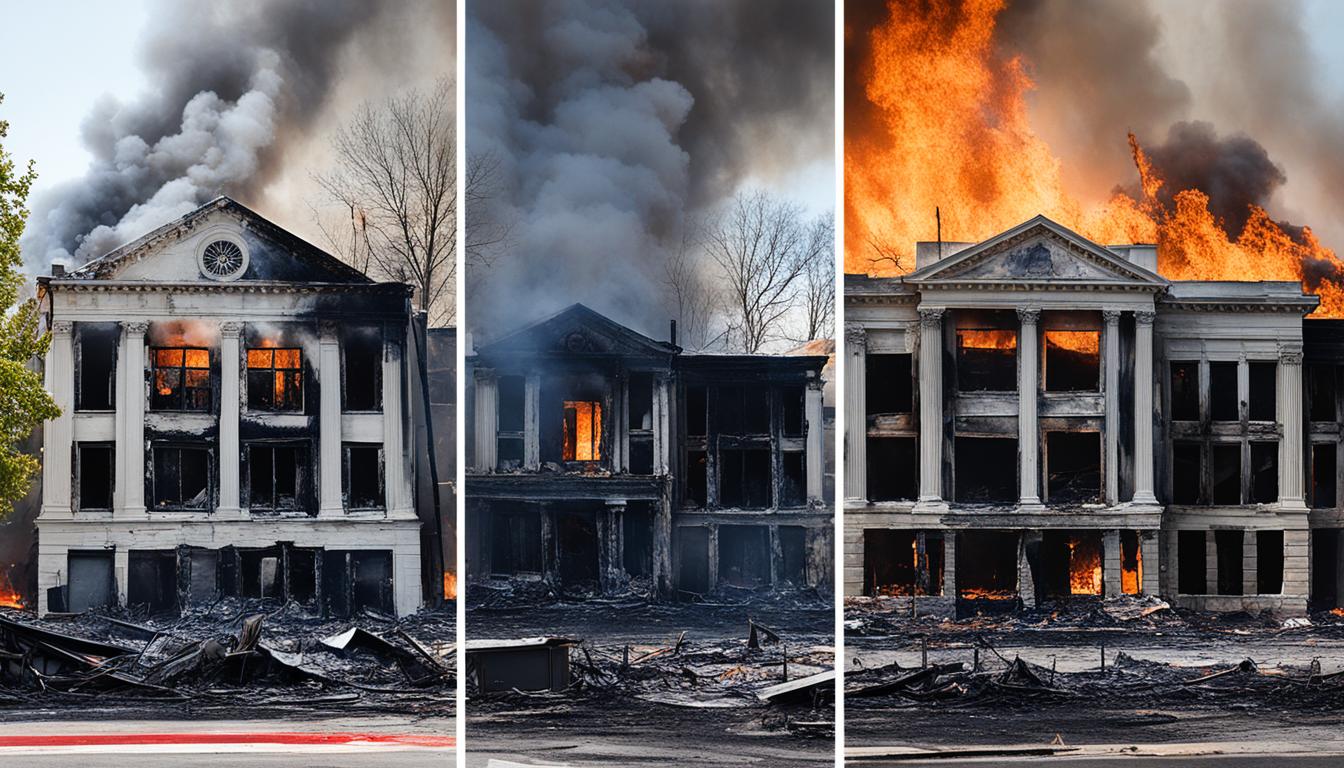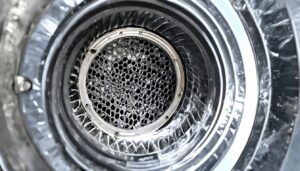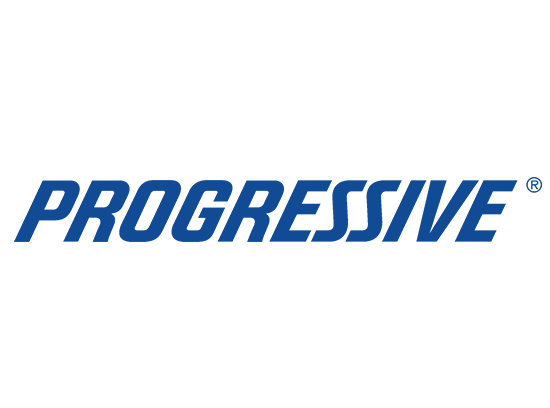Fire damage can have devastating effects on homes and businesses, leaving behind a trail of destruction. But did you know that fire damage can be categorized into two distinct types? In addition to the flames that directly cause destruction, there is another form of damage that is often overlooked. Are you aware of the difference between primary and secondary fire damage? Are you prepared to address both types to prevent further destruction to your property?
In this article, we will delve into the world of fire damage and explore the nuances between primary and secondary damage. We will uncover the hidden impacts of fire, understand the destructive forces at play, and learn how to effectively restore and recover from the aftermath. Join us as we unravel the mysteries of primary and secondary fire damage.
Key Takeaways:
- Primary fire damage is caused directly by flames, resulting in charring, melting, and destruction of materials.
- Secondary fire damage is caused by smoke and water, leading to staining, discoloration, odors, warping, swelling, and rotting.
- Understanding both types of fire damage is crucial for comprehensive restoration and recovery efforts.
- Soot and smoke residues can cause corrosion and health issues if not promptly addressed.
- Water damage from firefighting efforts can weaken structures and create an environment for mold and deterioration.
Understanding Fire Damage and Its Impacts
Fire damage can have a wide range of impacts on both residential and commercial properties. In addition to the obvious physical damage caused by the flames, there can be significant repercussions from smoke, soot, and water.
Smoke can permeate walls and other surfaces, leaving behind stains and a lingering odor. It can also pose health risks and cause respiratory issues. Soot, another byproduct of fire, can cause corrosion and damage to metal surfaces.
Furthermore, water used in firefighting efforts can result in structural weakness, mold growth, and other long-term issues. The extensive application of water to extinguish the flames can saturate building materials, leading to warping and rotting.
Understanding the full extent of fire damage is crucial for effective restoration and recovery. It is important to address all aspects of fire damage, including the impacts of smoke, soot, and water, in order to minimize further destruction to your property and mitigate potential health hazards.
Exploring Primary Fire Damage: Flames and Beyond
Primary fire damage is directly caused by the flames themselves. When a fire breaks out, it can quickly engulf and destroy various materials within a property. Walls, floors, ceilings, furniture, and personal belongings can all succumb to the destructive power of the flames.
The intense heat produced by the fire can cause structural damage, weakening load-bearing beams and walls. This structural instability not only poses a risk to the safety of the building but also makes it more difficult to restore and repair the affected areas.
In addition to physical destruction, fire damage goes beyond the visible damage caused by the flames. It can have a profound emotional and psychological impact on homeowners. Seeing their cherished possessions and the place they called home reduced to ruins can be devastating.
To better understand the extent of primary fire damage, it is crucial to assess the materials that have been burned and consider the overall structural integrity of the property. Proper evaluation and documentation of the damage are essential for effective restoration and recovery.
“What is primary and secondary fire damage?” – Secondary Damage Explored
Secondary fire damage refers to the effects caused by smoke and water. Smoke can travel throughout a property, leaving behind stains and discoloration on walls, furniture, and other surfaces. It can also cause respiratory problems and trigger asthma attacks. Water damage is another common consequence of firefighting efforts. The use of water to extinguish the flames can result in soaked building materials, leading to rotting, warping, and structural instability. Secondary fire damage can be just as destructive as primary damage and should not be overlooked.
To fully understand the consequences of fire, it is important to consider the secondary damage that can occur. Smoke, with its toxic chemical components, can permeate materials, leaving behind unsightly stains and discoloration. It can also pose serious health risks to residents due to the inhalation of soot particles. Additionally, the water used to extinguish the fire can cause further destruction, compromising the structural integrity of the building and promoting the growth of mold and mildew. Therefore, addressing both primary and secondary fire damage is crucial in the restoration process.
Smoke damage can have long-lasting effects and can be difficult to remove. Professional cleaning and deodorizing services are often required to effectively eliminate smoke residues and restore the affected areas. Water damage, on the other hand, necessitates immediate action to prevent further decay and mold growth. The extraction of excess water and thorough drying are essential steps in mitigating the consequences of water damage. By addressing both smoke and water damage promptly and comprehensively, the restoration process can be expedited and the extent of the damage minimized.
In conclusion, secondary fire damage encompasses the detrimental effects of smoke and water. It is important to acknowledge and address these consequences to ensure a thorough restoration process and minimize further destruction. By understanding the impacts of secondary fire damage, homeowners and businesses can take appropriate steps to mitigate the damage and restore their properties to their pre-fire condition.
Smoke Damage as a Leading Secondary Effect
Smoke damage is a significant secondary effect of a fire. When a fire occurs, smoke can infiltrate porous materials, resulting in stains, discoloration, and a pungent odor. The effects of smoke damage extend beyond the visible signs, as it can also cause respiratory issues and other health problems. Properly addressing smoke damage is crucial to prevent long-term issues and the need for extensive restoration efforts.
Cleaning smoke damage requires specialized techniques and equipment. Professional restoration services employ advanced methods to effectively remove soot and restore the affected areas. By using targeted cleaning agents and innovative technology, they can eliminate smoke particles and neutralize the odor. Promptly addressing smoke damage is essential to mitigate its harmful effects and ensure the successful recovery of the property.
Failure to address smoke damage promptly can lead to lingering odor, persistent stains, and further deterioration of materials. The longer smoke damage remains untreated, the more challenging it becomes to restore the affected areas. Professional restoration services should be contacted immediately to assess the extent of smoke damage and implement the necessary measures for effective cleaning and restoration.
Water Damage: A Common Consequence of Firefighting Efforts
When a fire breaks out, the immediate response is often to use water to suppress the flames and prevent further damage. However, while water is effective in extinguishing the fire, it can also result in its own set of damaging effects. Water damage is a common consequence of firefighting efforts and must be addressed promptly to prevent further destruction and minimize the risk of mold growth.
Water used in fire suppression can saturate building materials, causing structural weakness and deterioration. The excessive moisture can lead to warping, swelling, and even rotting of wood, drywall, and other porous materials. This can compromise the stability and integrity of the affected structure, requiring extensive repairs and restoration.
Mold growth is also a significant concern when dealing with water damage caused by fire suppression. The high levels of moisture provide an ideal environment for mold spores to thrive and multiply. If left unaddressed, mold can spread rapidly and pose serious health risks to the occupants of the property.
To mitigate the effects of water damage and restore the affected areas to their pre-fire condition, it is essential to seek professional water damage restoration services. These experts have the knowledge, experience, and equipment necessary to effectively assess the extent of the damage, remove excess water, and thoroughly dry the affected areas. They can also implement measures to prevent mold growth and ensure a safe and healthy environment.
In summary, water damage is a common consequence of firefighting efforts. Promptly addressing water damage is crucial to prevent further destruction, structural instability, and mold growth. Professional water damage restoration services are essential in minimizing the long-term effects and restoring the affected areas to their original state.
Tackling Secondary Fire Damage: Prevention and Response
Preventing secondary fire damage requires proactive measures and a timely response. By taking necessary precautions, you can minimize the risk of further destruction to your property.
1. Remove sources of water: Identifying and fixing any leaky pipes or plumbing issues can help prevent water damage during a fire. By eliminating potential sources of water, you can reduce the extent of damage caused by firefighting efforts.
2. Promptly clean up: After a fire, it is crucial to promptly clean up soot, smoke residues, and charred debris. These substances can continue to cause damage and emit strong odors if not properly addressed. Thorough cleaning will help prevent further deterioration and ensure a healthier living environment.
3. Install fire protection systems: Having a working fire protection system is essential for early detection and containment of fires. Install smoke alarms and fire sprinklers to alert you and help control the spread of flames, minimizing both primary and secondary fire damage.
4. Develop a response plan: It is crucial to have a well-defined plan in place to respond effectively to fire damage. This plan should include contacting professional fire restoration services to assess and restore your property. Timely intervention can prevent secondary damage from exacerbating the situation.
By implementing these preventive measures and responding swiftly to fire damage, you can minimize the long-term consequences and restore your property to its pre-fire condition.
Conclusion
Fire damage, whether it is primary or secondary, can wreak havoc on both residential and commercial properties. It is crucial for homeowners and business owners to understand the different types of fire damage and their effects in order to effectively restore and recover their properties. Prompt response and thorough cleaning are essential in minimizing the long-term consequences of fire damage.
Restoring fire-damaged property requires professional expertise and specialized restoration services. By working with experienced professionals, homeowners and business owners can ensure that the restoration process is handled efficiently and effectively. [Brand Name] offers comprehensive fire damage recovery solutions, including smoke mitigation, soot removal, and water damage restoration.
Preventing secondary fire damage is equally important. Taking proactive steps to remove potential sources of water, such as leaky pipes, can help minimize the risk of water damage during a fire. Additionally, having a working fire protection system in place, such as fire alarms and sprinklers, is crucial for early fire detection and containment.
With the right measures in place and the assistance of trusted professionals, homeowners and business owners can restore their fire-damaged properties and regain a sense of security. Don’t let fire damage control your life—take action today to restore your property and start the recovery process. Contact [Brand Name] for a comprehensive assessment and personalized fire damage restoration plan.
FAQ
What is primary fire damage?
Primary fire damage refers to the destruction caused directly by the flames themselves. This includes charring, melting, and destruction of materials. It can also lead to structural damage and the emotional impact on homeowners can be significant.
What is secondary fire damage?
Secondary fire damage is caused by smoke and water. Smoke can cause staining, discoloration, and odors, while water can result in warping, swelling, and rotting. Both types of damage should be addressed promptly to prevent further destruction to your property.
What are the impacts of fire damage?
Fire damage can result in significant physical destruction and also have repercussions from smoke, soot, and water. Smoke can permeate surfaces and leave behind stains and odors, while water can lead to structural weakness and mold growth.
What does primary fire damage include?
Primary fire damage includes the burning and destruction of materials such as walls, floors, ceilings, furniture, and personal belongings. It can also cause structural damage and emotional distress.
What does secondary fire damage refer to?
Secondary fire damage refers to the effects caused by smoke and water. Smoke can stain and discolor surfaces, while water can lead to warping, rotting, and structural instability. It is equally destructive as primary damage and should not be overlooked.
What is smoke damage?
Smoke damage is a significant secondary effect of a fire. It can penetrate porous materials, leaving behind stains, discoloration, and a strong odor. It can also cause respiratory issues and other health problems.
What is water damage?
Water damage is a common consequence of firefighting efforts. The use of water to extinguish the flames can result in soaked building materials, structural weakness, mold growth, and deterioration. Promptly addressing water damage is crucial to prevent further destruction and minimize the risk of mold growth.
How can secondary fire damage be prevented?
Preventing secondary fire damage requires proactive measures and a timely response. This includes removing sources of water, promptly cleaning up soot and debris, and having a working fire protection system in place. It is also important to have a plan for quick and effective response to fire damage, including contacting professional fire restoration services.
How can fire damage be restored?
Fire damage restoration requires prompt response, thorough cleaning, and professional restoration services. By taking proactive steps to prevent secondary damage and working with experienced professionals, homeowners and business owners can restore their properties and regain a sense of security.














